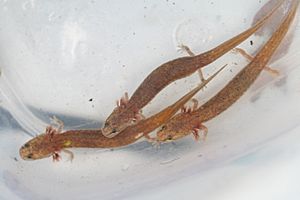Georgetown salamander facts for kids
Quick facts for kids Georgetown salamander |
|
|---|---|
 |
|
| Conservation status | |
| Scientific classification |
The Georgetown salamander (Eurycea naufragia) is a special type of salamander. It's also called the San Gabriel Springs salamander. These salamanders belong to the Plethodontidae family. They are found only in certain springs and caves. These places are located in Williamson County, Texas, close to Lake Georgetown. Sadly, their homes are shrinking. This is due to habitat loss from new buildings and the creation of Lake Georgetown. The scientific name, naufragia, means "remnants" in Latin. This name reminds us that only a few parts of their original home are left.
Contents
What They Look Like
Georgetown salamanders are small creatures. They live in water all the time. Adult salamanders are usually about 5–7.5 cm (2.0–3.0 in) long. They are less than 0.5 cm wide.
Their color can be different. Most adults are dark brown, dark olive, or gray. Young salamanders, called juveniles, are often darker. Their color is mostly on their back and sides. Their belly is usually clear. Many salamanders have a light stripe on top of their tail. This stripe can be cream or yellow.
Their head looks a bit like a shovel. It is wide but short. It is widest where their upper and lower jaws meet. They have three large gills on each side of their head. These gills are often deep red. Their eyes are quite big and have gold-colored centers. Black spots are found around each eye. They form a black circle and a line. This line goes from the eye to the nose. They also have 14 to 16 grooves on their sides.
Where They Live
The Georgetown salamander lives in wet caves and springs. These are found in the San Gabriel River area. This area is in Williamson County, Texas. Salamanders have been seen in 14 different spots in the county. Some of these are old records. Studies are still happening at two of these places. Most salamanders are found very close to where the spring water comes out of the ground.
Life Cycle and Habits
Most amphibians, like frogs and salamanders, live part of their lives in water and part on land. But the Georgetown salamander is different. It stays in the water its whole life. It keeps its gills and flat tail, even as an adult. This is called neoteny. It's a common trait for many Eurycea salamanders. The Georgetown salamander is active all year long.
Scientists think these salamanders lay eggs in the winter. This is when many other Eurycea species reproduce. They might lay about 30 to 50 eggs at a time. But they probably lay them one by one. Baby salamanders are about 1 cm long when they hatch. They grow fast until their body is about 3 cm long. After that, their growth slows down. Some might even get a little smaller. The young stage usually lasts from two months to three years. Other similar salamanders can live for five to 15 years. We don't know the exact lifespan of the Georgetown salamander yet.
Protecting Them
All the known groups of Georgetown salamanders live in an area that is growing very fast. This means more buildings and roads. This growth causes problems for the salamanders.
One big problem is that the water they need is running low or getting dirty. This water comes from the Edwards Aquifer. An aquifer is like a huge underground sponge that holds water. When more buildings are put up, more land is covered with concrete and roads. This is called "impervious cover." It means less rainwater can soak into the ground to refill the aquifer. Instead, the water runs off and can carry pollution into the aquifer. Pumping too much water from the ground also makes the aquifer levels drop.
Another threat is "sedimentation." This happens when dirt and sand wash into the springs. This can fill up the tiny spaces where salamanders live. They need these spaces to hide and find food.
Right now, only one group of Georgetown salamanders lives in a protected area. A group called the Texas Commission on Environmental Quality tries to keep the water clean. But their rules don't cover everything. They don't control how much land is covered by buildings. They also don't control pollution from things like fertilizers and pesticides. All these things are a danger to the salamander's home.
Efforts to Protect Them
In 2011, some groups like WildEarth Guardians and the Center for Biological Diversity took legal action. They said the US Fish and Wildlife Service (USFWS) was too slow. The USFWS had not decided if certain animals, including the Georgetown salamander, should be protected. Because of this, the USFWS agreed to review these animals by 2016.
In 2011, the USFWS announced they would formally review Eurycea naufragia. They also looked at three other Eurycea salamanders from central Texas. These were the E. chisholmensis, E. tonkawae, and E. waterlooensis. The goal was to see if they should be listed as endangered species. This review process is still happening.


